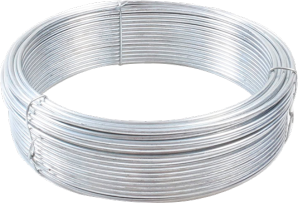Why Is Barbed Wire Used For A Construction Site Fencing? - Fencing Wire

Fencing Wire
Barbed wire is made from steel, which is coated with zinc. It is rust-resistant, durable, and weather-resistant. It is made up of twisted wires with pointed 'Barbs' attached at specific intervals. When used for fencing, the barbs work as deterrents and do not allow any unauthorised individual or animal to cross over.
Barbed wire fencing provides an affordable option for protecting construction sites. Often, construction sites have a limited budget and using this fencing wire can be an economical option. It can be used for all types of areas, whether it is a city or a rural setting. The fencing requires little maintenance, and only periodic inspections and minor adjustments are required.
Barbed wire fencing is lightweight and needs only a few tools for installation. This allows the contractors to seal the sites quickly. The sharp, pointed barbs prevent the intruders from crossing the fence and thus prevent theft or vandalism. The wires are rust-resistant and can withstand extreme weather conditions, like sun, rain and snow.
Benefits of using barbed wire fencing
- Barbed wire fencing is an economical option when compared to other fencing, like electric or concrete walls. The fence can be easily removed and reused for securing other sites, which adds to its cost-effectiveness.
- Barbed wire can withstand extreme weather conditions and last for years with little maintenance.
- Barbed wire fencing can be installed quickly, which helps to save time. It can be used as a fencing solution for different applications like industrial zones, residential sites and agricultural land.
- The fence helps to save the valuable assets by preventing intruders from entering. It deters humans as well as stray animals from the site.
- A barbed wire fence requires only periodic checkups and little maintenance.
- The height and the spacing of the barbed wires can be adjusted as per the specific needs.
- Barbed wires are made from recyclable material, which makes them an environmentally friendly option.
The various types of barbed wires are PVC-coated barbed wire, standard barbed wire, high-tensile barbed wire, reverse twist barbed wire and razor barbed wire.
- The PVC-coated barbed wire has improved protection against rust.
- The standard barbed wire is most widely used for protection.
- The high-tensile barbed wire is used in applications requiring a high level of protection..
- The reverse twist barbed wire has improved durability and strength.
- The razor barbed wire has sharp edges and can provide maximum protection.
When installing a barbed wire fence, first check the site to understand the security requirements. Select the right barbed wire type and the posts. Fix the posts at required intervals and stretch and attach the barbed wire to the posts. Ensure even tension in the barbed wires. Check for loose wires and make required adjustments.
The barbed wire fencing should be checked periodically for damage, rusting and loose fittings. The fence should be clear of all greenery and debris. The wire should be re-tightened to maintain security. Worn-out or broken wires should be replaced immediately. Anti-rust coating can be applied periodically to increase the lifespan of the wires.